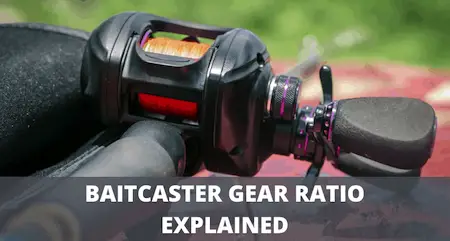Baitcaster Gear Ratio Guide – Which One Should You Choose?
UPDATED 08 MAY 2023
by Robert Ceran
If you’re new to fishing, chances are you’re a little confused about the different baitcasting reel models and gear ratios, and wondering which one is right for you.
In this article we’ll cover the three main baitcaster gear ratio categories, and will explain what each of them is used for, so you can choose the best one for your purposes.

Fishing reel gear ratio explained
A fishing reel gear ratio is a three digit number that describes how many times its spool rotates every time you turn the handle once.
For example, a 7.5:1 gear ratio means that the spool rotates 7.5 times for every single turn of the handle.
In other words, the higher the gear ratio, the faster the retrieve speed of your reel. In general, casting reels are faster than spinning reels, which usually go from 5.1:1 to around 6.5:1, while baitcasters start around 5.5:1, and go all the way up to 9.3:1.
Baitcaster gear ratio
Baitcasting reels usually have a higher gear ratio than spinning reels, and as a result are often used for fishing applications with high speed retrieval.
But you can also get models with a low gear ratio, if that works better for your purposes.
The three main categories of baitcaster gear ratios are: slow, medium and fast, which together cover all the different fishing tactics and applications you can use this reel type for.
Baitcaster gear ratio chart
| Gear ratio | Speed category | Retrieve rate | Main applications |
|---|---|---|---|
| 5.5:1 to 6.6:1 | Slow speed | 23" to 27" | Fishing heavy lures (e.g. big crankbait and swimbait) |
| 6.7:1 to 7.9:1 | Medium speed | 28" to 33" | Standard applications (e.g. spinner baits, swimbaits, plastic worms, bottom bouncing rigs, etc.) |
| 8.1:1 to 9.3:1 | High speed | 34" to 39" | Open water fishing, long casting, pitching/flipping, targeting bass close to cover |
The baitcaster gear ratio chart above covers the 3 main speed categories of baitcasting reels, plus the fishing applications they are most commonly used for.
Now let’s look at each of these speed categories in more detail.
Low speed baitcaster
Let’s start with a low speed bad casting reel, which is anything from 5.0:1 to 6.9:1.
These are mostly used for fishing high resistance lures, or heavy lures that you’re casting long distances, and that create a lot of resistance in the water (such as deep diving crankbaits, large rigs and big swimbaits).
A low speed gear ratio on a casting reel works just like the low gears on a bicycle.
A low speed generates a lot of torque when you turn the handle, which allows you to fish big baits without getting exhausted during the day, so reels in this category are great for those applications.
Medium speed baitcaster
Next, we’ve got medium speed reels, which includes models with a gear ratio from 7.1:1 to 7.9:1.
This is a really good standard gear ratio for baitcasters that can be used for a wide variety of fishing tactics – anything involving spinnerbaits, chatter baits, or shallow diving crankbaits.
Medium speed reels are also good for bottom bouncing tactics with worms, jigs, and Carolina rigs.
Most casting reels nowadays fall in this moderate speed category, and the great thing about them is that they are well suited for a wide variety of tactics.
So if you’re looking for a single speed you can use for everything, this is the one to go for.
Especially if you’re a beginner, we suggest choosing a reel in this category, and once you’re more experienced you can start trying out the other models, and test more specialized applications and tactics.
As a beginner, you probably also want to get a reel with effective backlash technology. For more information on this, check out our review on the best baitcaster for beginners.
High speed baitcaster
Now let’s look at high speed reels. These reels include anything that’s 8.1:1 or higher.
Some of them actually go all the way up to 10.1:1, which is an ultra high speed reel. An example of this is the KastKing Speed Demon, which has a ratio of 9.3:1.
High speed baitcasters are useful for:
- Targeting schooling fish in open water
- Long casts and quick retrieval
- Pitching or flipping from a drifting boat
- Targeting bass close to cover
Let’s look at each of these applications in more detail:
When you’re fishing for schooling fish in open water, it can be tricky to stay on top of the fish, and you might notice that the school has moved to a different spot right after you’ve made a cast.
In that case you want to retrieve your lure as fast as possible, so you can cast it again to the new location.
Fast reels are also good for tactics where you’re making long casts and then retrieving your lure through a strike zone that’s far away.
After you’ve covered the strike zone, you want to be able to reel it in really quickly so you can make another cast.
Also, when you’re jigging, pitching or flipping from a drifting boat, you usually only get 1 or 2 casts in each fishing spot, and if you miss the target on your first cast, you want to be able to retrieve your bait very quickly, so you get a second chance to hit the strike zone before you’re out of range.
Finally, whenever you’re targeting bass close to cover, such as lily pads or submerged trees, you run the risk of getting the fish snagged on that cover right after setting the hook.
That’s where a high speed reel comes in very handy, as it allows you to haul that bass away from the danger zone as fast as possible.
What is the best gear ratio for baitcaster?
The best gear ratio for a baitcaster is determined by the type of lure or fishing rig that you want to throw with it.
In case you’re not sure which speed is best for you, just start with a medium speed model that has a gear ratio between 6.7:1 and 7.9:1, since this can be adapted for almost any purpose.
With that being said, any of the different speed categories can be great for catching fish, depending on the specific tactic you’re using, and you can refer to our chart and discussion above to figure out which one is best for you.
Best gear ratio for bass fishing
Most bass anglers prefer medium to high speed reels ranging from 6.7:1 to 9.3:1 gear ratio.
The reason for this is that bass are often found close to cover, and if you hook a bass close to cover, you want to be able to haul it away from the cover before it can snag the line, and having a high speed reel helps a lot with that.
Also, bass pros usually like to use reels that are on the faster end of the scale.
This is because they want to waste as little time as possible retrieving their lure after it is out of the strikezone, so they can make another cast right away to maximize the chances of catching more fish.
A great all round reel for bass is the Tatula 100 (for more details check out our article comparing Daiwa Tatula 100 vs 150).
Conclusion
So hopefully that covers baitcaster gear ratio for you, and will help you to choose the right one for your fishing tactics.
To summarize: the best reel speed to choose as a beginner is a medium speed model, since you can use that for almost anything.
Then, as you become more experienced, you can start experimenting with lower and higher speed models.
Tight lines and see you on the water!
